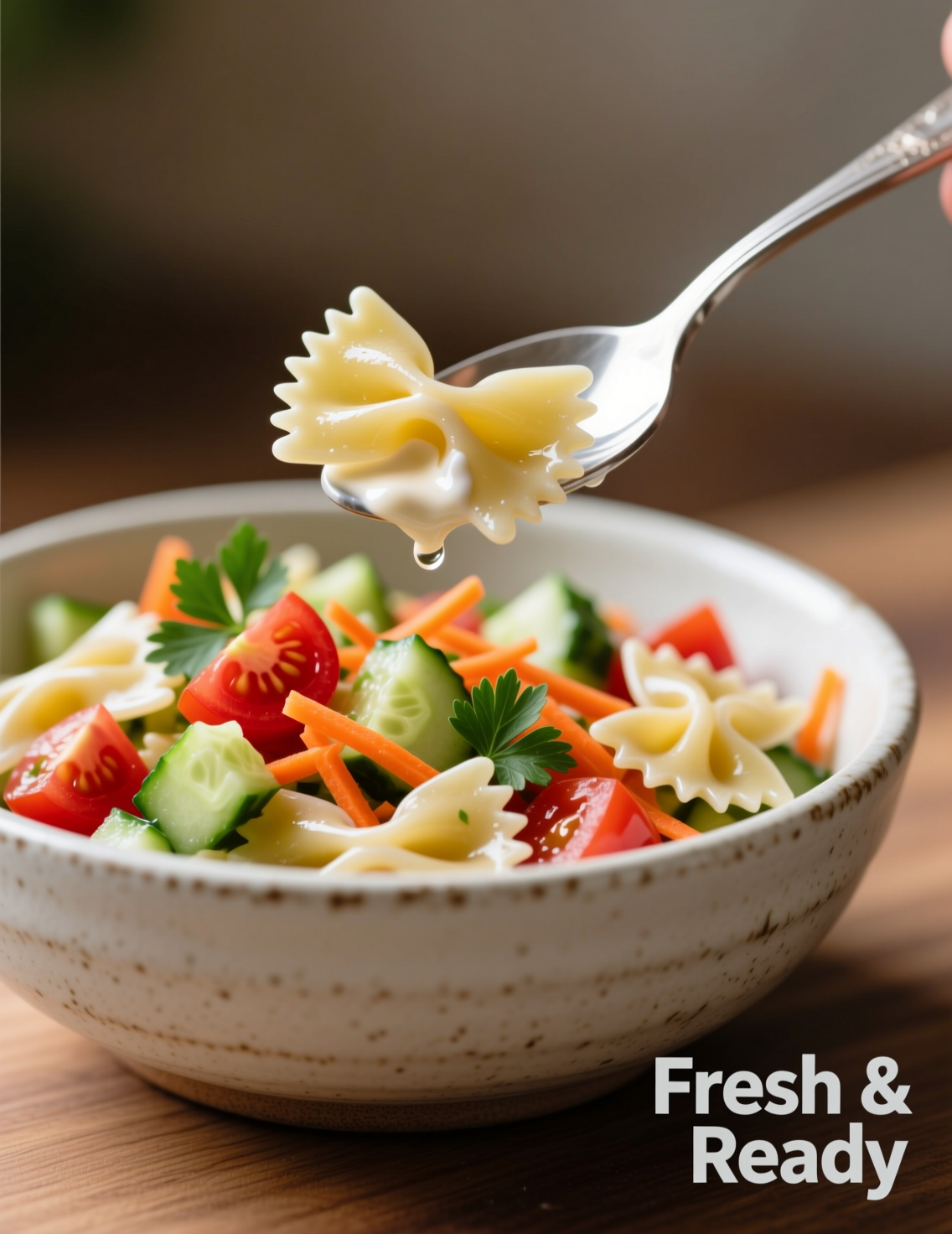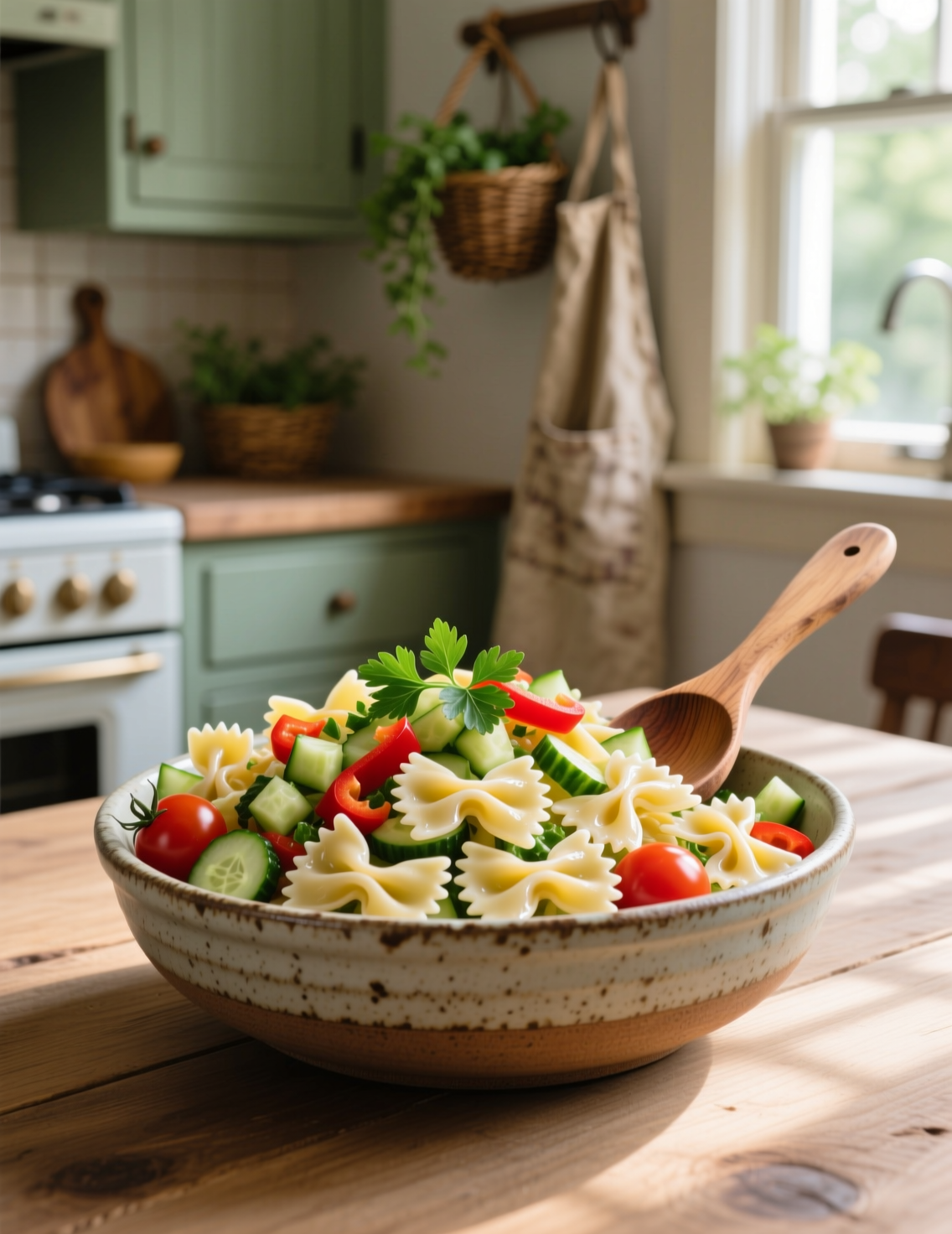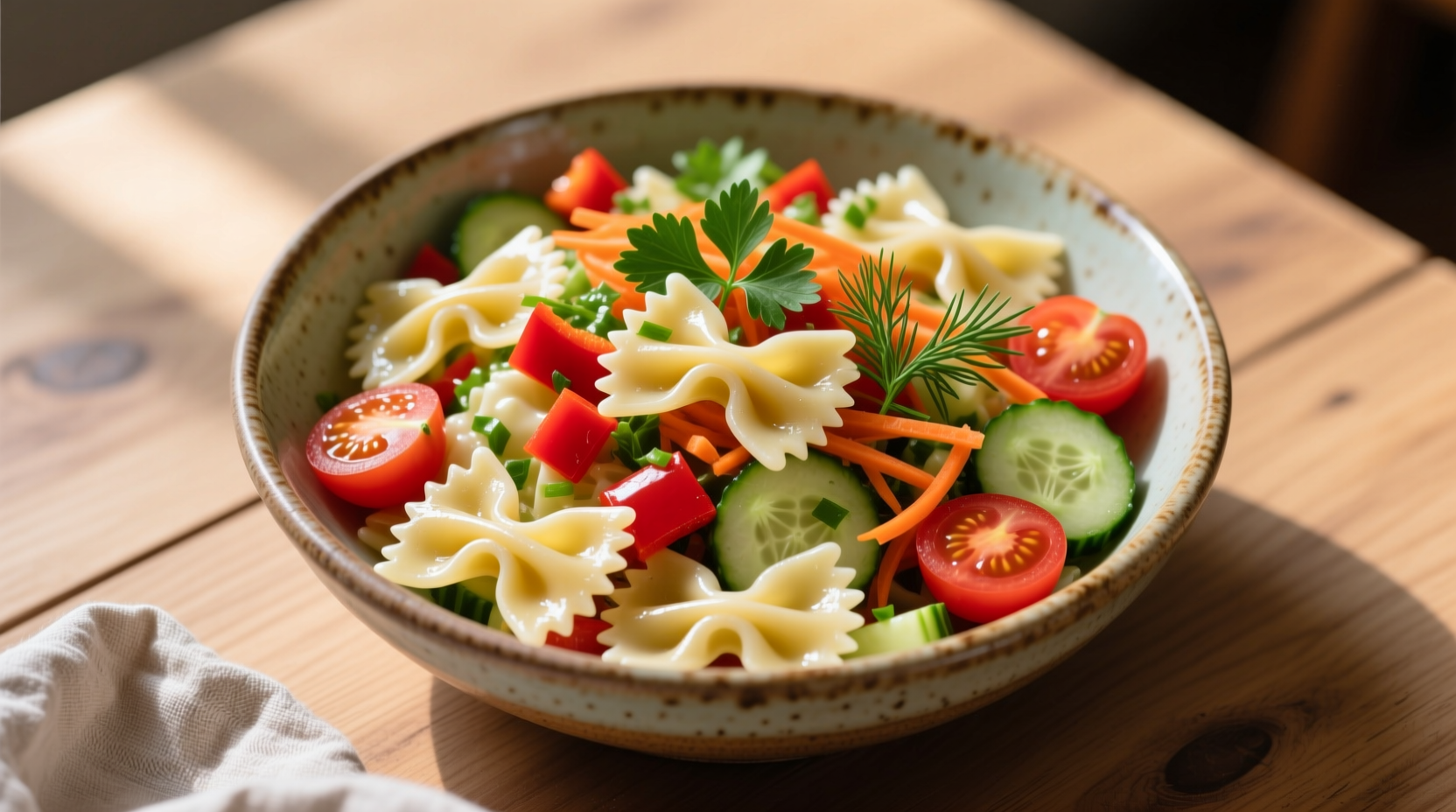Sometimes, the simplest things steal the show. A Cold Bowtie Pasta Salad is one of those quietly brilliant dishes that turns heads without trying too hard. It’s crisp, colorful, creamy—or tangy, depending on your mood—and somehow feels like summer no matter when you eat it. This isn’t just a backyard potluck thing; it’s a staple for caterers, chefs, and anyone who understands balance in flavor and texture. Let’s get right into what makes this cold pasta salad worth every bite.
The Art and Science Behind a Perfect Cold Pasta Salad
Let’s be honest. Most people think making pasta salad is just tossing noodles with mayo and calling it a day. But the real secret lies in temperature control, ingredient ratio, and timing. When pasta cools, it firms up, so cooking it just past al dente is essential—about one extra minute beyond the usual time. You want the noodles tender but not soggy.
Bowtie pasta, or farfalle, works best because those little pinched centers hold onto dressings and bits of veggies like magic. According to a 2023 culinary survey by Food Business News, bowtie pasta ranks among the top three shapes preferred by professional chefs for cold salads. Why? It keeps its structure even after refrigeration.
Ingredients You’ll Need
Here’s what you need for 4 servings, though let’s be honest—people always go back for seconds.
For the salad:
- 8 oz bowtie pasta
- 1 cup cherry tomatoes, halved
- ½ cup red bell pepper, diced
- ½ cup cucumber, sliced thin
- ¼ cup red onion, finely chopped
- ½ cup black olives, sliced
- ½ cup shredded mozzarella or feta (your call)
- 2 tablespoons fresh parsley, chopped
For the dressing:
- ¼ cup extra-virgin olive oil
- 2 tablespoons red wine vinegar
- 1 tablespoon Dijon mustard
- 1 garlic clove, minced
- ½ teaspoon salt
- ¼ teaspoon black pepper
- ½ teaspoon sugar (trust me—it balances the acid)
You can adjust these measurements to taste, but proportions are everything in pasta salad. Too much dressing, and it turns greasy; too little, and the pasta absorbs it all and dries up.

Cooking the Pasta: The Subtle Trick No One Talks About
Boil the bowtie pasta in salted water—about 1 tablespoon of salt per quart. Most cooks under-season, which leads to bland pasta that even the best dressing can’t save. When it’s done, drain but don’t rinse immediately. Let it cool slightly for 2–3 minutes first. Then rinse quickly with cold water to stop the cooking process and remove excess starch.
Here’s a trick from restaurant kitchens: toss the pasta in a tablespoon of olive oil after draining. This prevents sticking without affecting the final texture.
Building Flavor Layers
Now comes the fun part—layering flavor like a pro. The thing about pasta salads is that they’re not really about the pasta. They’re about what clings to it.
Toss your cooled pasta with half of the dressing first. Let it sit for about 15 minutes while you prep the veggies. This waiting period allows the noodles to soak up some of that flavor base. Then add your chopped vegetables and cheese. Finally, drizzle the remaining dressing just before serving.
Professional caterers often use this two-step dressing technique to keep salads flavorful even after refrigeration. Without it, your salad might taste flat or dull the next day.
Balance of Texture and Taste
Every ingredient here plays a role. The tomatoes bring sweetness and juiciness. The cucumbers add crispness. Red onion brings that sharp bite that cuts through the oil. Olives give umami depth, and cheese rounds it all with fat and creaminess.
The goal is contrast—soft against crunchy, bright against mellow. It’s the same reason why chefs rarely skip herbs in pasta salads. Fresh parsley or basil injects life into an otherwise dense dish.
And if you want to add protein, grilled chicken, shrimp, or even roasted chickpeas fit perfectly. But keep the ratio in check—protein shouldn’t overpower the pasta and vegetables.
Variations from Around the World
Pasta salad has gone global, evolving differently depending on where you are. In the U.S., creamy mayo-based versions dominate picnics. In Italy, they lean toward olive oil, vinegar, and herbs—light and zesty.
In Greece, it takes a Mediterranean spin: feta cheese, olives, oregano, and maybe a squeeze of lemon juice. In Asia, soy-ginger dressings with sesame seeds are common. The bowtie pasta’s adaptability makes it a universal favorite.
A study by the International Pasta Organization showed that cold pasta dishes increased in popularity by 27% worldwide from 2018–2022, largely due to health trends and meal-prepping culture. People love food that’s easy to make ahead yet still looks stunning in a bowl.
The Dressing: Why Ratios Matter So Much
Let’s get nerdy for a second. A well-balanced vinaigrette usually follows a 3:1 ratio of oil to acid. Here, we slightly shift that to 2:1 to brighten the flavor since cold food dulls taste perception. That means you need more acid than usual to make the flavors pop when chilled.
Adding a bit of sugar helps balance out the tartness of vinegar and mustard. This isn’t about making it sweet—it’s about achieving roundness. Even pro chefs sometimes skip this and end up with a dressing that feels harsh.
Also, emulsify your dressing. Whisk until it thickens slightly. That ensures it clings evenly to the pasta rather than pooling at the bottom of the bowl.
Storing and Serving Tips
This salad tastes best cold, but not fridge cold. If you’re serving it later, let it rest at room temperature for about 15–20 minutes before serving. This relaxes the flavors and prevents that stiff, oily texture cold olive oil can sometimes create.
Store leftovers in an airtight container for up to 3 days. If it dries out, add a splash of vinegar and a drizzle of olive oil before serving again. It’ll revive the flavors beautifully.
And one small insider’s tip—never mix the cheese too early if you’re storing overnight. It can turn mushy or overly salty. Add it right before serving instead.

Common Mistakes (and How to Fix Them)
1. Overcooked pasta: Once pasta overcooks, there’s no coming back. Always set a timer. Cook just one minute past al dente for cold salads.
2. Too much dressing: The pasta absorbs dressing as it chills, so start light and adjust later.
3. Skipping acid: Without vinegar or lemon juice, your salad will taste flat and heavy.
4. Storing while warm: Never refrigerate warm pasta salad—it breeds bacteria and ruins texture. Cool first, always.
5. Using only one texture: Add something crunchy—nuts, seeds, or raw veggies—to avoid monotony.
Expert Insight: The Chemistry of Cold Flavor
When pasta chills, starches contract slightly, making them firmer and less absorbent. This is why cold pasta salad tastes different from warm pasta dishes. To counteract this, professionals often slightly overseason or overdress salads before refrigeration. That way, when it chills, it balances out perfectly.
Another subtle thing—temperature affects flavor perception. Cold dulls sweetness and saltiness by up to 30%. So what tastes bold at room temp might taste muted later. Adjust seasoning accordingly.
Make It Gourmet
Want to elevate this to restaurant level? Try one or two of these tweaks:
- Use roasted cherry tomatoes instead of raw for caramelized sweetness.
- Add sun-dried tomatoes or marinated artichokes for depth.
- Swap vinegar for white balsamic or lemon juice for a citrusy lift.
- Toss in a few arugula leaves just before serving for peppery contrast.
Little upgrades like these transform a humble salad into something that feels chef-curated.
Nutritional Snapshot
A 4-serving bowl of this cold bowtie pasta salad roughly provides:
- Calories: 380 per serving
- Protein: 9 g
- Carbs: 44 g
- Fat: 18 g
- Fiber: 3 g
It’s light enough for lunch yet filling enough for dinner when paired with grilled meat or bread.
FAQs About Cold Bowtie Pasta Salad
Can I make this salad ahead of time?
Yes, absolutely. In fact, it tastes better after a few hours when the flavors meld together.
What’s the best cheese to use?
Feta gives a salty tang, while mozzarella adds a soft creaminess. Both work beautifully.
How can I make it vegan?
Skip the cheese and use a lemon-garlic vinaigrette or vegan feta.
Can I use a different pasta shape?
Sure, but bowtie pasta holds dressings and toppings best due to its surface shape.
Is it safe to leave out at a picnic?
Yes, but not for more than two hours, especially if using cheese or mayo-based dressing.
Final Thoughts: A Lesson in Simplicity
Cooking doesn’t always need complexity. This Cold Bowtie Pasta Salad is proof that with the right balance of texture, temperature, and taste, even a 20-minute recipe can feel like a crafted meal. It’s humble, fresh, and ridiculously adaptable.
Whether you’re plating it for a wedding buffet, serving it in a deli, or just making it for a quiet lunch, this salad whispers something chefs already know—great food isn’t about doing more; it’s about doing better.
And that’s exactly what this recipe does, every single time.
FAQs
Can I make this Cold Bowtie Pasta Salad ahead of time?
Yes, it actually tastes better after a few hours as the flavors blend beautifully.
What type of cheese works best in this salad?
Feta gives a tangy bite, while mozzarella offers a creamy, mild flavor—both are great choices.
How long can I store the salad in the fridge?
You can store it in an airtight container for up to 3 days for the best taste and texture.
Can I substitute another pasta shape for bowtie pasta?
Yes, but bowtie pasta holds the dressing and veggies better than most shapes.
How do I keep the pasta from sticking together?
Toss it with a tablespoon of olive oil right after draining to prevent clumping.
Is this recipe vegetarian-friendly?
Yes, it’s completely vegetarian as long as you use plant-based cheese or skip it.
Can I make this pasta salad vegan?
Absolutely—just leave out the cheese or replace it with vegan feta.
How do I prevent the salad from drying out?
Add a small drizzle of olive oil or vinegar before serving to refresh it.
What’s the ideal serving temperature?
Serve slightly chilled or at room temperature for the best flavor and texture.
Can I add protein to this recipe?
Yes, grilled chicken, shrimp, or chickpeas blend perfectly without overpowering the salad.
Why does the dressing taste different when cold?
Cold temperatures dull flavors, so slightly increase acidity or seasoning before chilling.
What should I do if the salad turns too acidic?
Balance it with a pinch of sugar or an extra drizzle of olive oil.
Can I use store-bought dressing?
You can, but homemade dressing gives fresher, more balanced flavors.
How can I make this salad look more appealing for guests?
Add colorful veggies like roasted peppers or garnish with fresh herbs before serving.
Is this salad safe for outdoor picnics?
Yes, but keep it chilled and don’t leave it out for more than two hours.

Mariana is a passionate home cook who creates delicious, easy-to-follow recipes for busy people. From energizing breakfasts to satisfying dinners and indulgent desserts, her dishes are designed to fuel both your body and hustle.
When she’s not in the kitchen, she’s exploring new flavors and dreaming up her next recipe to share with the Foodie Hustle community.

